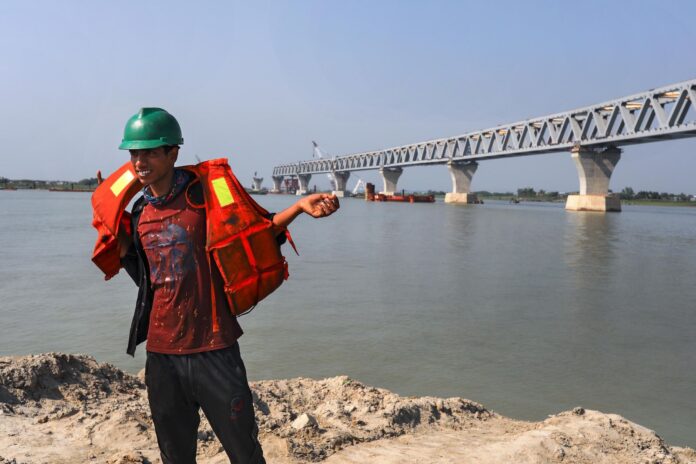A number of infrastructure projects are being implemented in Bangladesh in collaboration with China. Several of these works are nearing completion. Analysts believe that Dhaka has adopted ambitious plans around these projects on the way up the ladder of economic development.
In April 2021, a special report was published in China Daily, a newspaper run by the ruling Communist Party of China, mentioning the importance of the Chinese project in the development of Bangladesh. It said Bangladesh plans to move from a least developed to a developing country by 2026. One of the keys to achieving this goal is China’s cooperation.
A number of infrastructure projects, including the $3.3 billion Padma Bridge under construction in Bangladesh, are part of China’s proposed Belt and Road (BRI) initiative. Other Chinese-funded projects in the country include the $1.1 billion Payra Power Plant, the $1.32 billion power grid development, and a $1 billion digitization project.
The Bangladesh Investment Development Authority is also trying its best to retain potential investors, especially those from China. They are in constant touch through webinars and other virtual platforms. However, it is true that if the projects under Chinese BRI are fully functional, Bangladesh would benefit hugely. The Chinese projects are boosting Bangladesh’s economy. Bangladesh is benefitting from the BRI
In this regard, Economists in Bangladesh said that Bangladesh is heavily dependent on the success of China’s BRI-related infrastructure projects.
According to Bangladeshi media outlets, just the Padma bridge would boost Bangladesh’s GDP by more than one percent once the work is completed. It will benefit at least 30 million people in the southwest.
The bridge would not only connect 21 districts but also help them become centres of economic growth. Some of these districts will emerge as new economic corridors. This will create a huge number of new jobs and increase income.
According to a report in China Daily, Bangladesh, which is located between China and India, is seen as one of the main candidates in the race to become a major commercial and manufacturing hub. Prime Minister Sheikh Hasina sees BRI as an opportunity for Bangladesh’s economic progress. To this end, she has also signed an agreement with China to establish investment cooperation.
Media reports also say, to attract more investment, the Bangladesh government has allocated about 775 hectares of land for Chinese investors to build a special economic zone in Anwara Upazila of the Chittagong region in Bangladesh. More than 60 Chinese businesses have expressed interest in bringing in about $280 million in investment.
In 2015, China became Bangladesh’s largest trading partner. After three years, they also became the top investor in this country. In that position, the Chinese investment in Bangladesh in 2019 was about $1.2 billion. Most of China’s investment in the country came after Chinese President Xi Jinping’s visit to Dhaka in 2016.
In 2017, Sino-Bangladesh bilateral trade reached $18.7 billion. Trade increased by 16.6 percent that year. That year, Bangladesh was China’s second-largest trading partner in South Asia. Bangladesh is now China’s main partner in the G2G project; It is also a major destination for Chinese investment. The Padma Bridge, the dream of the people of Bangladesh, is in full swing in collaboration with the Chinese contractor Major Railway Engineering Group. Many projects are being implemented across Bangladesh with the financial support of China, as has been done before. More projects await. China-Bangladesh cooperation is now the strongest, which speaks to the true potential of BRI cooperation.
According to the Bangladesh Investment Development Authority, BRI activities in Bangladesh became dynamic immediately after Chinese president Xi Jinping’s visit. During his 22-hour state visit, several investment agreements were signed between Bangladesh and China.
Work on BRI-related projects was progressing rapidly even in the wake of the recent coronavirus epidemic. However, last year saw a slight decline in foreign investment.
Now Bangladesh is going to see the implementation of the Padma bridge. The 6.15 km-long Padma Bridge will greatly enhance connectivity across Bangladesh and exemplifies China’s expanding soft power.
The Padma Bridge in Bangladesh, the construction of which was contracted to a subsidiary of China Railway Group, is nearing completion. The bridge will dramatically enhance connectivity across Bangladesh and lead to a more connected South Asia. The bridge’s construction has implications beyond the Bangladeshi economy, and will further portray Beijing as setting technological and construction standards in South Asia, thereby enhancing China’s soft power.
The Bangladesh Investment Development Authority is also trying its best to retain potential investors, especially those from China. They are in constant touch through webinars and other virtual platforms. However, it is true that if the projects under Chinese BRI are fully functional, Bangladesh would benefit hugely. The Chinese projects are boosting Bangladesh’s economy. Bangladesh is benefitting from the BRI.























